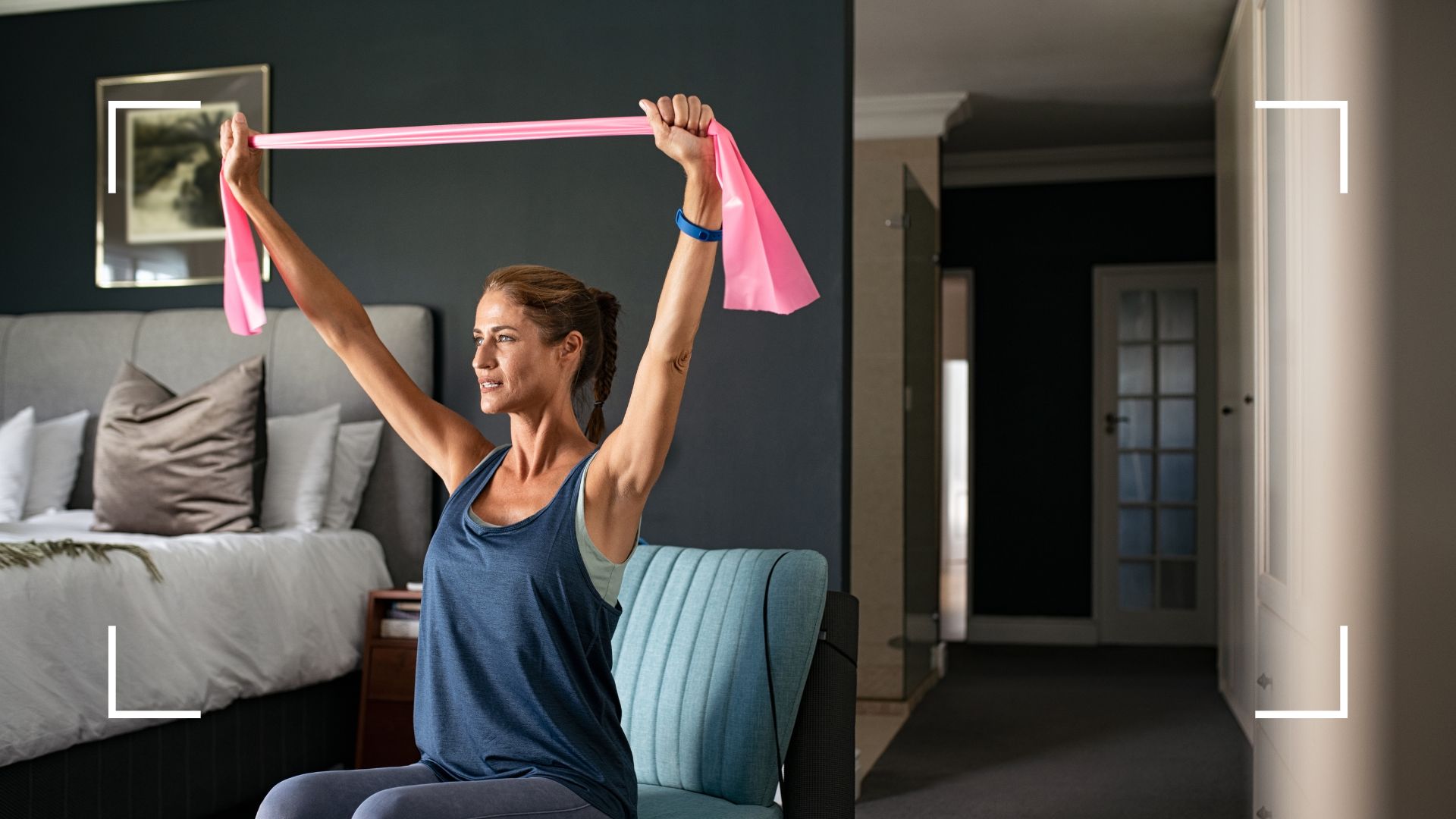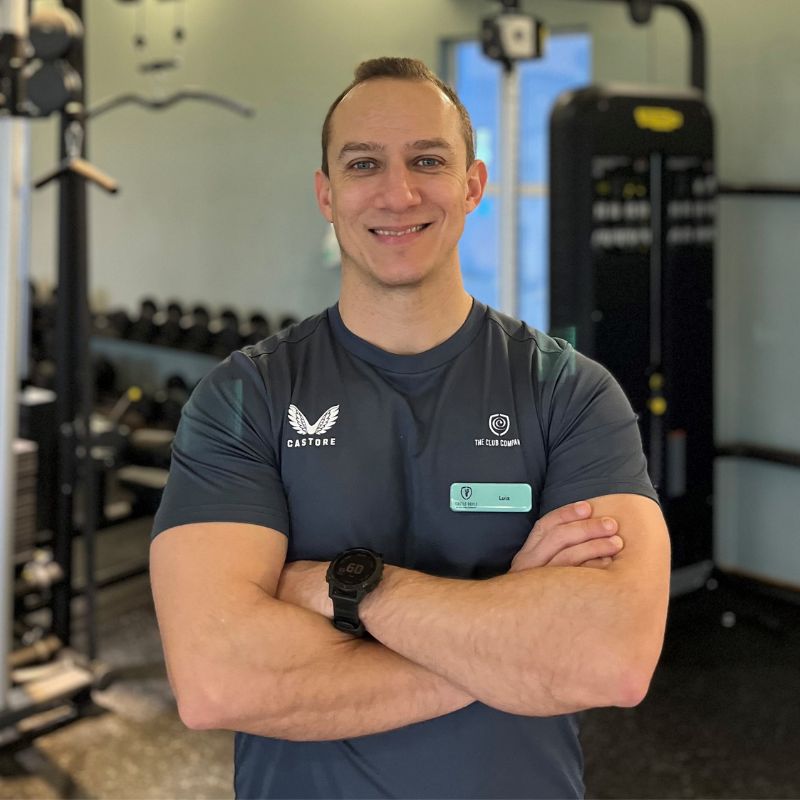This 7-move chair workout can help build strength and support your pelvic health
A good chair workout can help to improve mobility, build strength, support pelvic health and boost your mood.


Making time for a quick chair workout can help to improve mobility, build strength, support pelvic health and boost your mood. As the name might suggest, all you need is a comfortable and stable chair (without wheels) to get started.
A chair workout is a type of strength training, done with or without resistance like dumbbells. “It's particularly well suited to those with mobility issues, or who might be recovering from injury, alleviating pressure or pain from the associated body part,” explains Luiz Silva, a Level 4 qualified personal trainer. They’re also an easy way to introduce mindful movement into your day if you spend a lot of time sitting at a desk.
These low-impact exercises can be done anytime and anywhere and will encourage blood flow throughout the body supporting mobility, improving balance, building strength and even boosting your mood while reducing feelings of stress. Here, four experts share the best chair workout to add to your routine and how to get the most out of these gentle movements.
6-move chair workout
1. Knee lift
Knee lifts or knee tucks are a great all-rounder chair exercise that can help to improve hip mobility, while strengthening the thighs, back and abdominals. “Being able to lift the knees well by strengthening the hip flexor is a must, especially for those who may be at a greater risk of falling or those who want to improve their overall balance,” explains Silva, who is also the head of fitness and wellbeing at Castle Royle.
How to do it:
- Get comfortable on your chair.
- Place your hands in your lap or by your sides.
- With one foot planted on the floor, engage your core and thighs as you lift your other knee from a 90 degree angle straight up in front of you and back down again.
- Repeat 10 times on each side.

Luiz Silva is the head of Fitness & Wellbeing and a personal trainer at Castle Royle. He has a degree in Physical Education, Certificates III and IV in Fitness Instruction & Personal Training, a diploma in Fitness and Remedial Massage, and a Level 4 diploma in Nutrition and Weight Management.
2. Hamstring stretch
Suffer from back pain? Try adding a hamstring stretch into your chair exercise routine. Strengthening these muscles can help to reduce back pain in the long term by taking pressure off your pelvis and lower back. “Tight hamstrings will put your pelvis in an unnatural tilt. If the pelvis tilts when seated, we have to adjust and bend the back (especially the lower spine) to be able to stay more upright,” Silva explains. “This bent position will place your lower vertebrae and discs at risk.”
How to do it:
Sign up for the woman&home newsletter
Sign up to our free daily email for the latest royal and entertainment news, interesting opinion, expert advice on styling and beauty trends, and no-nonsense guides to the health and wellness questions you want answered.
- Sit towards the edge of your chair.
- Place one leg out straight in front of the other, while keeping the other leg bent at a 90 degree angle.
- Keeping one leg straight, straighten the back and begin to hinge at the hips.
- Lean forward gently until you begin to feel a stretch in the back of the leg.
- Hold for up to 30 seconds before repeating the same stretch on the other leg.
- Repeat three times on each side.
3. Chair squats
Squats are a great all-rounder to have if you're looking to do strength training for beginners at home. They can help to strengthen your quadriceps, glutes, hip flexors, and lower back muscles, and improve your balance, coordination, and mind-body connection all at once.
It's best if you start off using just your body weight but if you find these squats too easy then add some resistance. Resistance bands, for example, or a pair of adjustable dumbbells can help put your body under light pressure without risking injury.
How to do it:
- There are many types of squats you can do - but they all start the same way. Stand with your feet hip-width apart, toes facing slightly outward. Place your hands on your hips or have them clasped together in front of you.
- Keep your back straight and head up.
- Bend your knees, push your hips back and slowly lower yourself towards the chair.
- Move your weight onto your heels and push your knees out in the same direction your toes are pointing.
- Lightly touch the chair and push up, powering through your heels.
Pro Fitness Resistance Bands Set: £30 for 3
These long resistance bands are the perfect addition to a chair workout. Whether it's to add resistance to your squat or shoulder press, these bands are simple to use and made from premium materials that make them long-lasting easy and comfortable to use.
4. Glute kickback
Similarly, a glute kickback is a low-impact way to support your glute muscles, which helps to keep the upper body stable and stabilise the pelvis. Having strong glute muscles can also help to prevent some injuries if you do any intense cardio exercise, such as running or cycling as a workout. It's often a key movement in many strength training for runners workouts for the same reason.
How to do it:
- Stand behind your chair, feet together and hold onto the back of the chair for support.
- Lean forward slightly, making sure to keep your back straight and core engaged.
- Squeeze your glute and lift one leg out and back behind you, aiming for a 45-degree angle, pointing to the corner of the room.
- If you struggle to feel the contraction in your glute, it may help to bend your leg at the knee before lifting it up and out behind your body.
5. Overhead arm raise
Overhead arm raises can help to strengthen shoulder muscles and triceps. “Lifting your arms overhead in a chair replicates many daily activities such as reaching for items in a high cupboard,” says Silva. “Once this move starts getting easier and you build your strength, you can consider slowing the tempo or adding resistance.”
How to do it:
- Sit comfortably in your chair with back support.
- Slowly raise your arms above your head and back down.
- Repeat 10 times on each side.
- You can take this exercise a step further by using hand weights or holding a tin of soup to add extra resistance and weight.
If you find this exercise easy and want to make it harder, take a slice of the dumbbell workout for beginners and incorporate some handheld weights into your chair workout.
6. Ankle taps
Ankle taps might look easy, but this simple exercise will fire up your muscles, work your core and improve your hip mobility. “By trying to reach the ankle, we naturally need to hinge from the hip, which is one of our essential movements,” explains Silva. “By reaching the opposite ankle we also work on a small rotational move, which fires some of the deeper muscles in the core, and therefore strengthens the whole mid-section while also working the lower back muscles.”
How to do it:
- Sit comfortably in your chair.
- Gently hinge at the hips and engage the core.
- Reach down and touch the opposite ankle (left hand to right ankle).
- Return to a seated position and repeat with the other ankle.
- Do this exercise 10 times on each side.
- If you feel pressure on your back at any point, end the exercise
7. Isolated pelvic floor exercise
It’s easy to neglect pelvic floor exercises (also known as kegel exercises) but if you’re seated for most of the day, it’s the perfect opportunity to introduce chair exercises that support pelvic floor health - and they’re easy to do. “The pelvic floor muscles have some very important roles including keeping us continent, supporting our pelvic organs and contributing to our sexual pleasure,” says leading pelvic health physiotherapist Clare Bourne. “This exercise is the best way to start your pelvic floor strengthening journey.”
How to do it:
- In a seated position, connect with your pelvic floor muscles. To do this, first think about contracting your back passage as if you are holding in wind.
- Then bring this contraction forwards towards your pubic bone.
- Fully relax and breathe deeply.
- Repeat this movement 10 times.

Clare Bourne is a pelvic health physiotherapist based in London. She has specialised in pelvic health for the last nine years working in the NHS before moving into private practice. She has two young children and her journey through pregnancy, birth and the postnatal period has allowed her to experience for herself the importance of caring for our pelvic health through motherhood. Since 2020 Clare has been sharing regular pelvic health content and information on Instagram and has grown a following of nearly 50k.
Do chair workouts really work?
Yes, whether you're looking to strength training for weight loss or develop your strength and stability, chair workouts can be a hugely useful tool as they are adaptable - so you can target key muscle groups, add in cardio portions or somatic exercise - and as they are easy to do at home, many people will find it easier to fit a chair workout into their daily routine.
While there's no rule as to how many times a week you should do chair exercises, a regular chair workout can support physical and mental health in several ways - from improving stability and mobility to reducing tension in the mind and body. They are the best way for those with low mobility, reduced balance, or those who spend a lot of time sedentary to introduce some more movement into their day.
Best of all, chair exercises are accessible for most people as they require little to no equipment (except a chair) and can be completed anytime. For an exercise to be effective, it needs to be done regularly. Not everyone has time for an outdoor or a gym workout so a chair workout, as one of the best at-home workouts, may be a better option for some people.
As Bourne points out, for those with reduced mobility or those who work from home sitting down, chair exercises encourage blood flow, can help you sleep better, and have a positive impact on your mood while also helping you feel more in tune with different parts of the body, strengthening our mind-body connection.
The downsides? Despite the myriad of benefits of chair exercises, the variations are limited and as you become stronger you may find them less challenging. However, adding additional reps or weight can increase the intensity.
Tips for getting the most out of your chair workout
- Consider the chair you’re using: You must practise chair exercises on a comfortable and stable base with no wheels. Silva adds: “You should use a chair that offers the correct height for your exercise. A good tell is if your knees are at a 90-degree angle when seated.”
- Think about your space: If you spend a lot of time at your desk and want to add chair exercises into your day to encourage more movement, Silva suggests making sure you have plenty of space around you to perform the exercises without bumping into anything.
- Pick a variety of exercises: “A variation of movement patterns will cover you for a well-rounded workout,” says Danni Tabor, a co-founder of Lift Studio LDN with Mimi Bines. Consider adding chair exercises that involve, hinging at the hips, pressing, pulling, squatting and core engagement for a full-body workout. Equally, you might like to add some yoga mat exercises to your sequence or download one of the best strength training apps to change things up.
- Pay attention to your posture: “While performing chair exercise, ensure your posture is correct and that you do not hunch your back,” says Silva. Engage your core and if you feel your back has given way at any point, end the exercise.
- Tune into your breathing: Not only will synchronising your breathing with your exercises help you complete them more efficiently, but it will also relax your body and mind and help to reduce stress.
- Stay consistent: “It’s all about little and often,” says Bourne. If you find yourself forgetting to complete your chair exercises during the day try setting an alarm every hour or two to remind you to take 10 minutes for movement.
- Add resistance: “When exercises don’t feel challenging any more, add light hand weights,” advises Silva. If you don’t have weights to hand, try adding a tin or bottle of water to increase the resistance.
- Increase your reps: No equipment? No problem. “To progress you can add time to each session,” advises Tabor and Bines. “Start with two exercises, then the next week you can increase to three.”

Danni Tabor (left) and Mimi Bines (right) are certified personal trainers and strength training specialists. They are also the founders of Lift Studio LDN. Opening in April 2021, the studio has carved out a successful niche to become a leader in the women’s fitness space.
It might surprise you, but diaphragmatic breathing is one of the best techniques you can do as part of a chair workout to support your overall health and wellbeing. As well as helping to relax your body and your mind, Bourne points out this technique can also support pelvic health. “Our diaphragm and pelvic floor muscles move and work together, so learning how to do diaphragmatic breathing is really important for our overall pelvic floor function,” Bourne explains.
To do it: Place one hand on the side of your lower ribs and one hand on your lower tummy. Take a slow breath in, working on expanding your lower ribs and allow your tummy to gently expand. Then fully exhale and repeat this 10 times.
Ciara McGinley is a meditation practitioner and health journalist. She qualified as a meditation teacher with the British School of Meditation in 2020 and is the founder of Finding Quiet, a series of classes, workshops and retreats that combine meditation practices and mindfulness techniques to make mindful living realistic in an always-switched-on modern world. She is all about bettering that mind-body connection but believes wellness looks different to everyone.
Ciara is also the former Health Channel Editor at woman&home and has covered all things health and wellbeing for years, from fitness to sleep to relationships.
-
 Celebrities who overcame scandal and came back stronger than before - from Jane Fonda to Martha Stewart
Celebrities who overcame scandal and came back stronger than before - from Jane Fonda to Martha StewartScandals, controversies and fallouts can really harm a celebrity's reputation, but these stars proved there's power in putting in the work for a second shot
By Jack Slater Published
-
 Ranvir Singh’s denim midi dress is perfect for April date nights
Ranvir Singh’s denim midi dress is perfect for April date nightsYour favourite jeans will always be an easy outfit staple but denim dresses have the same comfort factor and more elegance.
By Emma Shacklock Published
